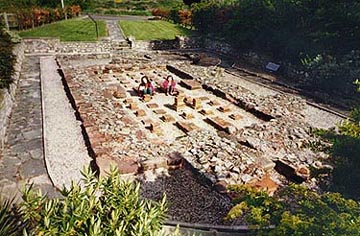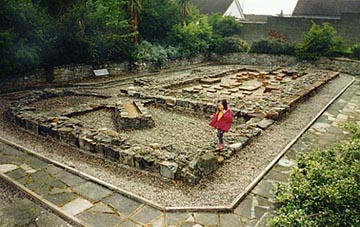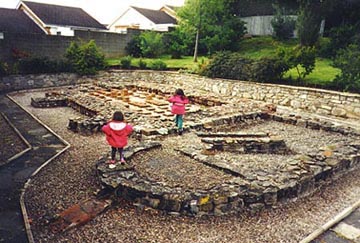A
Virtual
Stroll
Around
the
Walls
of
Chester
The Roman Bath House near Prestatyn, North Wales
 Situated in what is now Melyd Avenue, on the edge of the small North Wales resort town of Prestatyn, about 20 miles west of Chester, these well-preserved remains of a Roman civilian bath house were discovered on March 30th 1934 by Mr F. Gilbert Smith, a local architect, surveyor and enthusiastic amateur archaeologist. Situated in what is now Melyd Avenue, on the edge of the small North Wales resort town of Prestatyn, about 20 miles west of Chester, these well-preserved remains of a Roman civilian bath house were discovered on March 30th 1934 by Mr F. Gilbert Smith, a local architect, surveyor and enthusiastic amateur archaeologist.Prestatyn lies five miles north of the main east-west highway from the legionary fortress at Deva (Chester) into North Wales. It is very likely that a Roman branch-road linked the industrial settlement at Prestatyn- a government controlled centre of lead production- with the main highway near St. Asaph, and continued south through the territories of the Deceangi in the valley of the River Clwyd, to the fort at Ruthin and the Berwyn Mountains, the realm of the Ordovices. There is also some evidence that another road followed the coast south east to Deva via the silver/lead mines at Pentre (Flint) though this route may have been supplied by sea. The bath-house was built in about AD 120 and extended in about AD 150. It had a cold plunge-bath at the far end which was fed by a local spring by means of a timber aqueduct. The floors and roof were made with tiles transported all the way from the workshops of the 20th Legion at Holt near Wrexham, over 40 miles to the south-east, and may have been built by legionary masons. Some of these tiles, stamped with the legend LEG XX VV and their symbol of a wild boar, may be seen in situ to this day (but see update at bottom of page...) In reply to a letter from Professor Robert Newstead of Chester enquiring as to the nature of his discovery, Gilbert Smith wrote, "The Prestatyn site seems to have been a small military station occupied by a unit of the Twentieth Legion (LEG. XX VV); and if so, then the barrack blocks and headquarters buildings must have been erected within the lines of the defensive ditch on elevated ground... The presence of the bath house outside the ditch on the south is quite consistent with the general layout of Roman forts and small military stations. But why there should be traces of other buildings outside the defensive ditch is puzzling. I can offer no explanation, nor have I been able to find a parallel".  The site was excavated over successive seasons by Smith and Newstead until work ceased with the coming of the Second World War. The site was excavated over successive seasons by Smith and Newstead until work ceased with the coming of the Second World War.There things lay until 1984-5 when re-excavation of the bath house and surrounding area was undertaken by the Clwyd-Powis Archaeological Trust. Their work revealed part of a civilian settlement established shortly after AD 70. Samian Ware pottery discovered here indicates an occupation during the second century and there is evidence that the site continued to be occupied until the late 3rd or early 4th century AD. Apart from the stone bath-house all the other excavated buildings were of timber. Preservation of organic remains was good because of waterlogging, and in some cases parts the timbers of the Roman buildings had been preserved. Tantalising evidence also exists for the presence of other, more imposing stone buildings yet to be discovered within the settlement, in the form of fragments of stone columns and column bases which have been found in the immediate vicinity. Here is the page on CPAT's excellent website that describes and illustrates the excavation. Once their work was finished, the bath house and its immediate surroundings were consolidated and landscaped by Rhuddlan Borough Council and opened to the public, much as we are privileged to see it to this day. Twenty-odd miles away and twenty years earlier, things had been somewhat differently handled in Chester- the great legionary fortress of Deva. Readers of our Chester: a Virtual Stroll Around the Walls may recall our story of the discovery of a vast gymnasium and bath house complex "with walls up to two hundred feet long, standing to twelve feet in height", not a scrap of which was preserved in situ, or even effectively recorded, as a result of the construction of the Grosvenor Shopping Precinct by Grosvenor Estates during the 1960s. Strange but true. Mind you, remembering the oh-so-recent scandal of the erection of a County court house and associated car park by Deeside-based David McLean Developments on top of a substantial portion of the great military amphitheatre in Chester- perhaps not so strange after all. The residents, the local MP and some councillors are up in arms and who can blame them. In the face of overwhelming competition from the Mediterranean, fading seaside resorts such as Prestatyn need all the help they can get to attract visitors. The potential for this site, encompassing not only the as-yet undiscovered wonders lying beneath the ground (Roman historian D W Harris even conjectured that this may be the site of the 'lost' Roman settlement of Varae)- but also the beauty of the place with its wetlands and rich variety of wildlife (including at least 19 resident badgers, we're told)- could, properly managed, prove to be a priceless asset to the town and a magnet for visitors from all over the world. Photographed
in
1998
by
Steve
Howe-
with
the
assistance
of
daughters
Eve
and
Cleo. |
 Both of these latter changes were objected to by the local council and
Both of these latter changes were objected to by the local council and